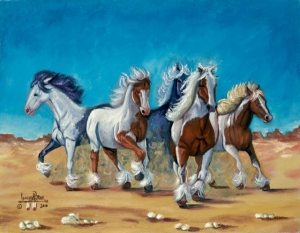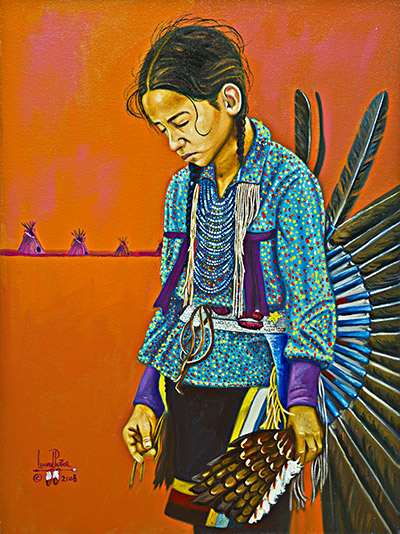The Man
The Artist
Not so very long ago, Leonard Peltier would have been the first one to say, “I’m a long way from my peak as an artist.”
Growing up with uncles who would spend time sketching and carving, Peltier would watch his elders in their craft and try to imitate them.
“I remember I started carving with a knife I had found in the trash and sharpened up. I learned to draw before I could read or write, and it was kind of a way to communicate for me… I took art classes in school… art was what I was good at. I began teaching myself painting and getting into colors just before I got arrested. After my arrest, I really didn’t do anything until about 1984 or 1985.”

Breaking Loose
Evolution of an Artist
Spending time in “the hole,” while in the federal prison at Springfield in the 1980s, Leonard watched another prisoner working with pastels and when he got permission to get his own set of pastels and paper, he started working with the images and colors that he has always loved.
Inside the gray walls of the prison, locked away from the natural beauty of Mother Earth and her changes, artists must take their inspiration from books and magazines available to them.
“We are denied seeing Mother Earth and enjoying her, so we use some nice pictures for models and change them around… I like to express the beauty of my culture to the world—the colors of powwow, dancers, drummers, and crafts. I want to record and share this beauty.”
After his transfer to the penitentiary at Leavenworth, Kansas, Leonard began to work with oils and acrylics.
Peltier must purchase supplies from the prison commissary at USP-Coleman, where he is currently imprisoned, but supplies are limited. He can order supplies through a catalog, but that is subject to approval. He isn’t limited in the quantity he can purchase, only by funds.

Rain Dog
The Artist’s Vision
Peltier’s paintings reflect the strength and commitment in his heart for the struggle of his People to retain a natural way of life in the face of great adversity. But painting means so much more to Leonard.
“Painting is a way to examine the world in ways denied me by the United States justice system, a way to travel beyond the walls and bars of the penitentiary. Through my paints I can be with my People—in touch with my culture, tradition, and spirit. I can watch little children in regalia, dancing and smiling; see my elders in prayer; behold the intense glow in a warrior’s eye. As I work the canvas, I am a free man.”
In 1986, Leonard suffered a stroke and lost about eighty percent of his sight in his left eye.
“My eye problems have slowed me down considerably, but I am still very inspired.”
Indeed, art professionals marvel at the number and quality of the paintings Peltier produces in light of this disability.
“Sharing my art makes my heart feel good. It’s a way, too, of letting people know that I have not been conquered by the oppressor even though I have spent so many years in these iron lodges. It’s a way to say thank you for all the people’s support. It’s a way of letting them know that their prayers are strong.”
Leonard donates his paintings to his defense committee to help support efforts to win his freedom. Leonard’s paintings are collected by celebrities and luminaries worldwide including Oliver Stone, Peter Coyote, Jane Fonda, Val Kilmer, and Michael Apted.
Peltier paintings also have been given as gifts and donated to help other organizations raise funds.
Artwork and art-related products are available from the CL Peltier Art Gallery here.
